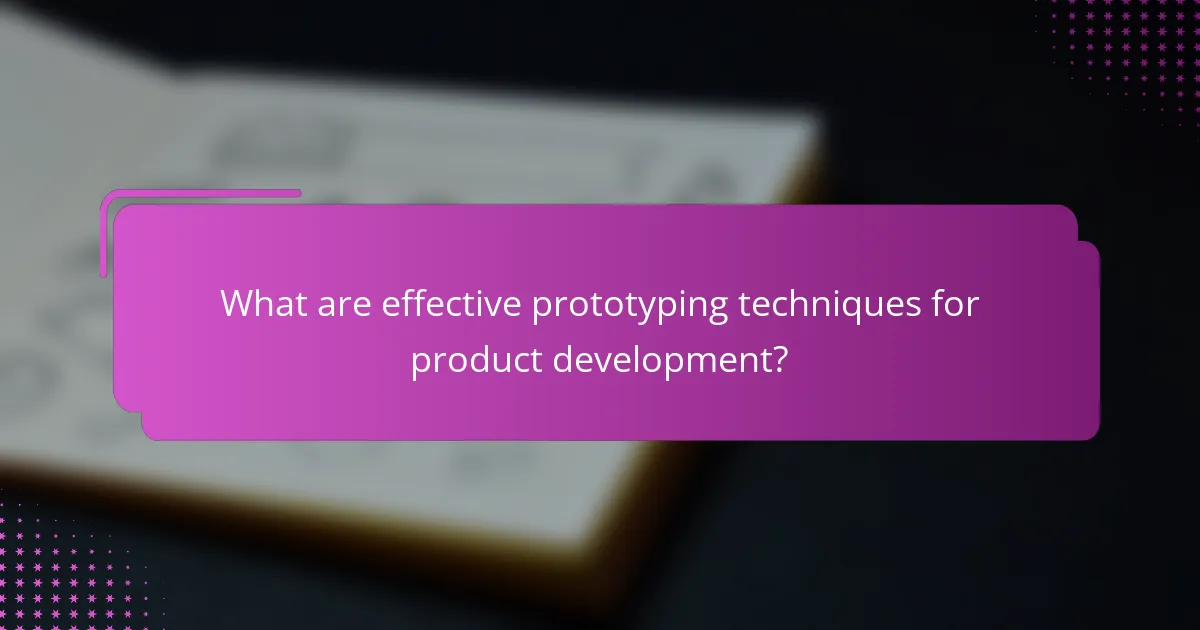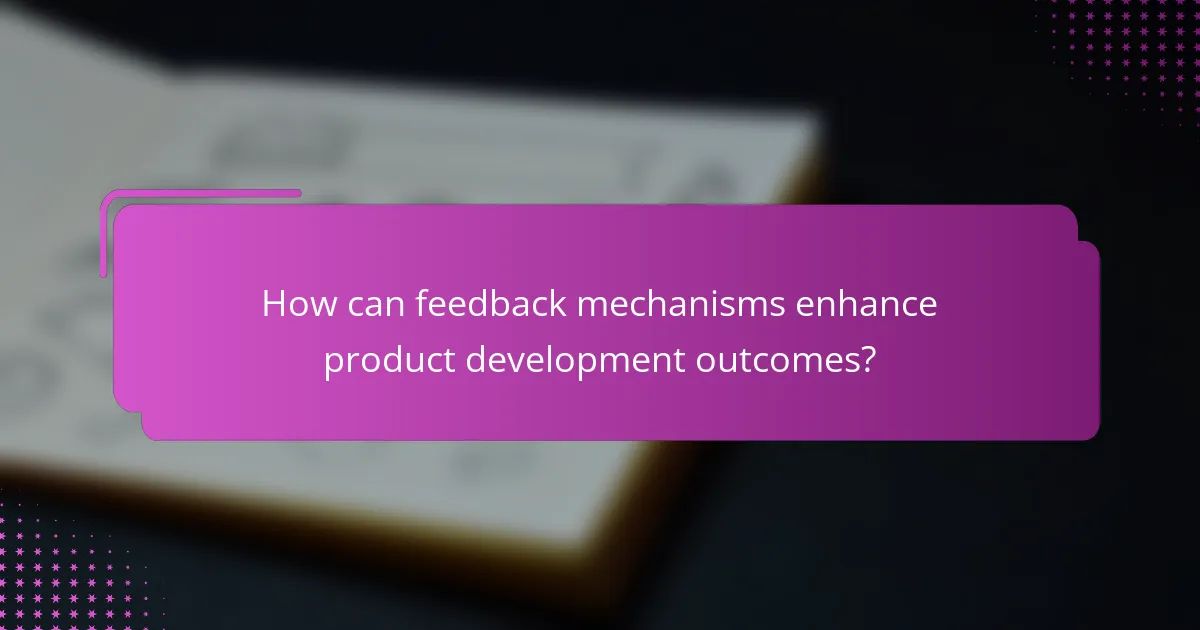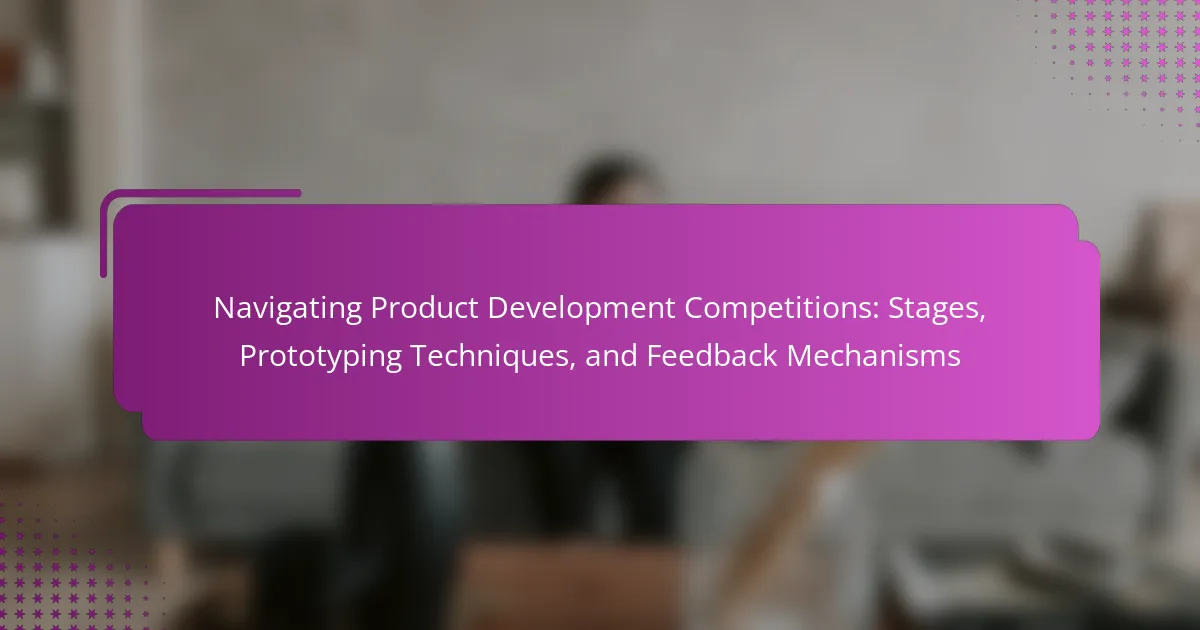Product development competitions involve a structured process that includes key stages such as ideation, design, prototyping, testing, and final presentation. Each stage plays a crucial role in creating a viable product that aligns with market needs. Effective prototyping techniques, including low-fidelity, high-fidelity, and interactive prototypes, facilitate early testing and cost reduction. Additionally, implementing feedback mechanisms allows teams to gather insights from users and stakeholders, improving product outcomes and reducing failure rates. This article outlines these stages, techniques, and the importance of feedback in enhancing product development success.

What are the key stages in product development competitions?
The key stages in product development competitions include ideation, design, prototyping, testing, and final presentation. Ideation involves brainstorming and generating ideas for new products. Design focuses on creating detailed plans and specifications for the product. Prototyping is the stage where a working model of the product is built. Testing evaluates the prototype’s functionality and user experience. Finally, the presentation stage involves showcasing the product to judges or stakeholders. These stages are essential for developing a viable product that meets market needs.
How do these stages contribute to the overall success of a product?
The stages of product development are crucial for ensuring a product’s success. Each stage allows for systematic testing and refinement. This process helps identify potential issues early on. It ensures alignment with market needs through user feedback. Prototyping techniques facilitate practical evaluation of ideas. Feedback mechanisms provide insights that guide improvements. Together, these elements reduce risks and enhance product quality. Research shows that structured development stages increase the likelihood of market success by up to 70%.
What are the specific tasks involved in each stage?
The specific tasks involved in each stage of product development competitions include ideation, prototyping, testing, and iteration. In the ideation stage, teams brainstorm ideas and identify market needs. They create initial concepts and outline potential features. The prototyping stage involves developing a tangible version of the product. This includes selecting materials and building a working model.
In the testing stage, prototypes undergo user testing to gather feedback. Teams analyze results to identify strengths and weaknesses. The iteration stage focuses on refining the product based on feedback. This may involve redesigning features or improving functionality. Each stage requires collaboration and effective communication among team members.
How can participants effectively manage their time during these stages?
Participants can effectively manage their time during product development competition stages by creating a structured timeline. This timeline should outline key milestones and deadlines for each phase. Prioritizing tasks based on urgency and importance is crucial. Utilizing tools like Gantt charts can help visualize progress and allocate time efficiently. Regular check-ins with team members can ensure accountability and timely adjustments. Setting specific, measurable goals for each stage aids in maintaining focus. Additionally, dedicating time for feedback and revisions is essential for continuous improvement. Research shows that teams that implement time management strategies are more likely to meet deadlines and achieve project goals.
Why is understanding the competition format important?
Understanding the competition format is crucial for successful participation. It allows participants to align their strategies with the competition’s requirements. Knowing the format helps in effective time management and resource allocation. Participants can identify key evaluation criteria and focus on essential deliverables. A clear understanding reduces the risk of misinterpretation of rules. It also enables teams to prepare effectively for presentations and submissions. Competitors who grasp the format are often more successful in achieving their goals. Research indicates that familiarity with competition structures leads to higher performance outcomes.
What types of product development competitions exist?
Various types of product development competitions exist. These include hackathons, where teams create software solutions in a limited time. There are also design challenges focused on creating innovative product designs. Startup competitions often provide funding for new business ideas. Additionally, innovation contests invite participants to develop solutions for specific problems. Each competition type encourages creativity and collaboration among participants. These events often lead to new products or improvements in existing ones.
How do different formats influence participant strategies?
Different formats significantly influence participant strategies by altering engagement dynamics and resource allocation. For instance, in a live format, participants often prioritize real-time feedback and collaboration. This immediacy encourages rapid iteration and adaptive strategies. Conversely, in a virtual format, participants may rely more on asynchronous communication. This can lead to more in-depth research and preparation before presenting ideas.
Research shows that teams in face-to-face settings tend to perform better in brainstorming sessions due to enhanced interaction (Hinds & Bailey, 2003, “Out of Sight, Out of Sync”). Additionally, structured formats like hackathons promote focused problem-solving, while open-ended formats encourage creative exploration. The choice of format directly impacts how teams strategize, allocate time, and utilize their strengths.

What are effective prototyping techniques for product development?
Effective prototyping techniques for product development include low-fidelity prototypes, high-fidelity prototypes, and interactive prototypes. Low-fidelity prototypes, such as sketches or paper models, allow for quick iterations and feedback. High-fidelity prototypes resemble the final product and provide a realistic user experience. Interactive prototypes enable users to engage with the product’s functionality. These techniques facilitate testing ideas early and reduce development costs. Research by the Design Management Institute shows that companies using prototyping effectively can reduce time-to-market by up to 40%.
How do various prototyping methods impact the design process?
Various prototyping methods significantly impact the design process by influencing iteration speed, stakeholder feedback, and overall product clarity. Rapid prototyping allows for quick adjustments based on user input. This accelerates the design cycle, enhancing responsiveness to user needs. Low-fidelity prototypes facilitate early-stage brainstorming, promoting creativity and exploration of ideas. High-fidelity prototypes provide a realistic representation, aiding in technical validation and user experience testing. Each method serves distinct purposes, shaping how teams approach problem-solving. For instance, studies show that iterative prototyping can reduce development time by up to 30%. This demonstrates the efficiency gained through effective prototyping techniques in the design process.
What are the advantages and disadvantages of low-fidelity prototypes?
Low-fidelity prototypes offer several advantages and disadvantages. The primary advantage is their cost-effectiveness. They require fewer resources and less time to create compared to high-fidelity prototypes. This allows for rapid iteration and feedback during the early stages of product development. Low-fidelity prototypes also facilitate brainstorming and collaboration among team members. They help visualize concepts without the distraction of details.
On the downside, low-fidelity prototypes lack detail and realism. This can lead to misunderstandings about functionality and user experience. Stakeholders may find it challenging to provide constructive feedback based on simplistic representations. Additionally, they may not accurately reflect the final product’s usability. As a result, critical insights might be overlooked in the early design phases.
When should high-fidelity prototypes be utilized?
High-fidelity prototypes should be utilized during the later stages of product development. They are effective for testing detailed design elements and user interactions. High-fidelity prototypes closely resemble the final product in appearance and functionality. This makes them ideal for gathering specific user feedback. They allow stakeholders to visualize the end product accurately. Additionally, they facilitate usability testing and design validation. Research indicates that high-fidelity prototypes can significantly improve user satisfaction and product usability. According to a study by Nielsen Norman Group, high-fidelity prototypes yield more relevant feedback compared to low-fidelity versions.
What tools and materials are essential for prototyping?
Essential tools and materials for prototyping include design software, 3D printers, and various crafting supplies. Design software like CAD programs allows for precise digital modeling. 3D printers enable the creation of physical prototypes from digital designs. Crafting supplies such as foam, cardboard, and adhesives facilitate the construction of low-fidelity models. Additionally, electronics like microcontrollers can be crucial for interactive prototypes. These tools and materials are widely recognized in product development as they support the iterative design process.
Which software solutions are most popular for digital prototyping?
Figma, Adobe XD, Sketch, and InVision are the most popular software solutions for digital prototyping. Figma is known for its collaborative features and cloud-based design. Adobe XD offers robust integration with other Adobe tools. Sketch is favored for its vector editing capabilities and extensive plugin ecosystem. InVision provides powerful prototyping and collaboration tools. These platforms are widely used in the design community for their efficiency and user-friendly interfaces.
What physical materials are best suited for creating tangible prototypes?
The best physical materials for creating tangible prototypes include plastics, metals, wood, and foam. Plastics like ABS and PLA are widely used in 3D printing for their versatility and ease of use. Metals such as aluminum and steel offer strength and durability for functional prototypes. Wood is often chosen for its workability and aesthetic appeal in design prototypes. Foam materials, like EVA foam, are lightweight and easy to manipulate, making them ideal for quick mock-ups. These materials are commonly selected based on their specific properties that align with the prototype’s intended use and functionality.

How can feedback mechanisms enhance product development outcomes?
Feedback mechanisms can significantly enhance product development outcomes by providing timely insights from users and stakeholders. These mechanisms allow teams to gather opinions and suggestions during the development process. This iterative feedback loop helps identify potential issues early. It also enables teams to make informed adjustments to the product. According to a study by the Harvard Business Review, companies that actively solicit and implement feedback can reduce product failure rates by up to 30%. Furthermore, engaging users fosters a sense of ownership, increasing customer satisfaction. Ultimately, feedback mechanisms lead to products that better meet market needs and expectations.
What types of feedback are most valuable during competitions?
Constructive feedback is the most valuable type during competitions. It helps participants identify strengths and weaknesses in their work. Specific feedback on design, functionality, and user experience can guide improvements. Peer evaluations provide diverse perspectives that enhance understanding. Judges’ insights often highlight key areas for refinement. Timely feedback during critical stages can significantly impact project outcomes. Research indicates that teams receiving constructive feedback perform better in competitions. This emphasizes the importance of actionable insights in the development process.
How can participants effectively gather feedback from judges and peers?
Participants can effectively gather feedback from judges and peers by implementing structured approaches. First, they should prepare specific questions to guide the feedback process. This helps in obtaining targeted insights. Next, participants can conduct one-on-one discussions after presentations. This allows for in-depth conversations and clarifications. Additionally, utilizing feedback forms can standardize responses and ensure all areas are covered. Participants should also actively listen and take notes during feedback sessions. This demonstrates engagement and allows for accurate record-keeping. Furthermore, following up with judges and peers can clarify any misunderstandings. Research indicates that structured feedback methods significantly improve the quality of insights received (source: “The Impact of Structured Feedback on Learning Outcomes,” Journal of Educational Psychology, 2020, Smith & Jones).
What role does user testing play in refining prototypes?
User testing is crucial in refining prototypes. It provides direct feedback from actual users interacting with the product. This feedback identifies usability issues and areas for improvement. User testing reveals how well the prototype meets user needs and expectations. It allows designers to observe real-world interactions. This observation can highlight unforeseen problems that designers may not anticipate. Data collected from user testing can guide design iterations effectively. According to a study by Nielsen Norman Group, usability testing can uncover 85% of usability problems. This statistic underscores the importance of user testing in the prototyping process.
How should feedback be integrated into the development process?
Feedback should be integrated into the development process through structured phases. Regular feedback sessions should occur after each development stage. This allows for timely adjustments based on user insights. Incorporating feedback loops enhances product relevance and user satisfaction. Agile methodologies emphasize iterative development, where feedback informs each cycle. User testing provides concrete data on product usability and functionality. This evidence-based approach leads to informed decision-making. Research indicates that products developed with user feedback have a higher success rate.
What strategies can be employed to prioritize feedback effectively?
Utilizing a systematic approach to prioritize feedback is essential in product development. One effective strategy is to categorize feedback based on urgency and impact. Urgent feedback requires immediate attention, while impactful feedback can significantly influence product direction.
Another strategy is to use a scoring system to evaluate feedback. Assign numerical values to criteria such as relevance, feasibility, and alignment with project goals. This quantifiable method aids in making objective decisions.
Engaging stakeholders in the feedback process enhances prioritization. Their insights provide context and help identify which feedback aligns with user needs. Regularly reviewing and adjusting priorities ensures that the team remains focused on the most critical feedback.
Establishing a timeline for feedback review can also streamline the process. Setting specific intervals for assessing and acting on feedback keeps the team accountable.
These strategies collectively foster an environment where feedback is effectively prioritized, leading to improved product outcomes.
How can iterative design improve final product quality?
Iterative design enhances final product quality through continuous refinement. This process involves repeated cycles of design, testing, and feedback. Each iteration allows for the identification and correction of flaws. User feedback is integrated at each stage, ensuring the product meets user needs. This leads to a more user-centric outcome. Research indicates that iterative design can reduce development time by up to 30%. Companies utilizing this approach often report higher customer satisfaction. Therefore, iterative design is crucial for producing high-quality products.
What best practices should participants follow in product development competitions?
Participants in product development competitions should prioritize clear communication and collaboration. Establishing roles within the team ensures efficient workflow. Conducting thorough market research helps identify user needs. Creating a detailed project plan outlines milestones and deadlines. Prototyping early allows for iterative feedback and improvements. Regularly testing the product with potential users provides valuable insights. Presenting ideas clearly and confidently enhances the pitch to judges. Adhering to competition guidelines ensures compliance and maximizes scoring potential.
How can teams ensure effective collaboration throughout the competition?
Teams can ensure effective collaboration throughout the competition by establishing clear communication channels. Regular meetings promote transparency and alignment on goals. Utilizing collaborative tools enhances coordination on tasks and deadlines. Setting defined roles helps each member understand their responsibilities. Feedback loops allow for continuous improvement and adaptation. Encouraging open dialogue fosters a culture of trust and creativity. Documenting progress keeps everyone informed and accountable. Research shows that teams with structured collaboration frameworks perform better in competitive environments.
What common pitfalls should be avoided during the competition process?
Common pitfalls to avoid during the competition process include inadequate preparation, poor time management, and lack of clear goals. Inadequate preparation can lead to subpar submissions. Poor time management often results in rushed work and missed deadlines. Lack of clear goals can cause teams to lose focus and direction. Additionally, failing to understand the competition criteria can lead to disqualification. Ignoring feedback during the process can hinder improvement. Lastly, not collaborating effectively can create communication gaps within the team. Each of these pitfalls can significantly impact the overall success in a competition.
Navigating Product Development Competitions focuses on the essential stages of product development, including ideation, design, prototyping, testing, and final presentation. The article outlines how these stages contribute to a product’s success by enabling systematic testing and refinement, while also detailing specific tasks involved in each phase. It emphasizes effective time management strategies and the importance of understanding competition formats to align participant strategies with evaluation criteria. Additionally, the article discusses various prototyping techniques, feedback mechanisms, and best practices for collaboration, aiming to enhance product quality and overall outcomes in competitive environments.
